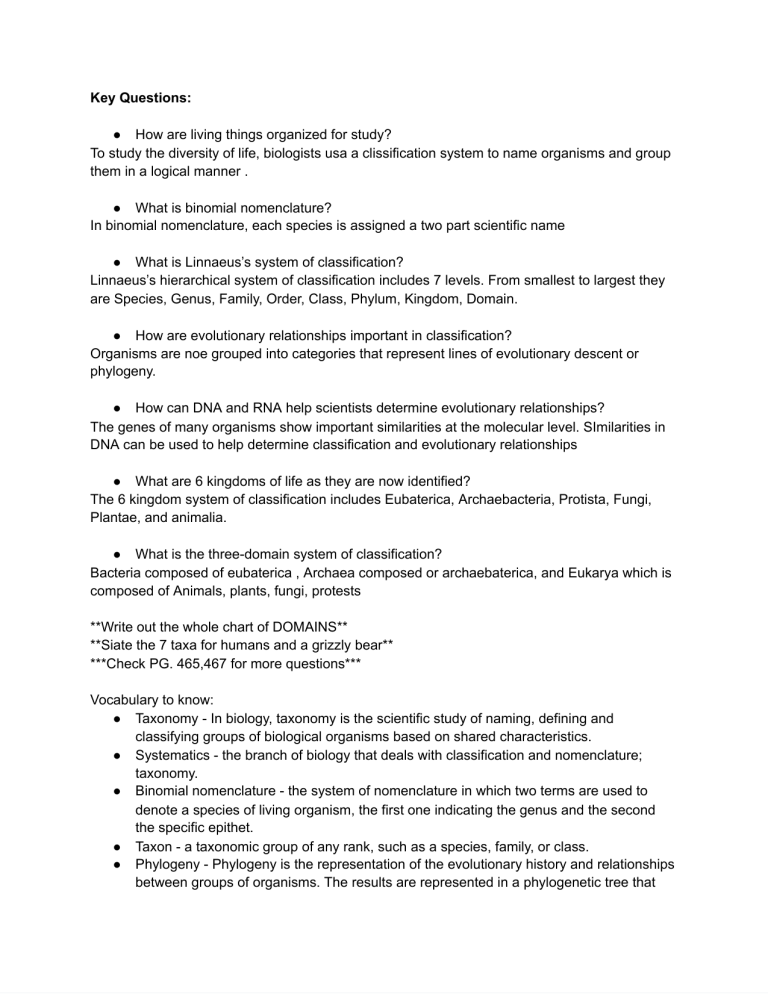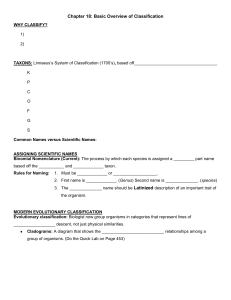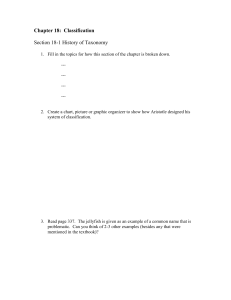
KeyQuestions: ● Howarelivingthingsorganizedforstudy? Tostudythediversityoflife,biologistsusaaclissificationsystemtonameorganismsandgroup theminalogicalmanner. ● Whatisbinomialnomenclature? Inbinomialnomenclature,eachspeciesisassignedatwopartscientificname ● WhatisLinnaeus’ssystemofclassification? Linnaeus’shierarchicalsystemofclassificationincludes7levels.Fromsmallesttolargestthey areSpecies,Genus,Family,Order,Class,Phylum,Kingdom,Domain. ● Howareevolutionaryrelationshipsimportantinclassification? Organismsarenoegroupedintocategoriesthatrepresentlinesofevolutionarydescentor phylogeny. ● HowcanDNAandRNAhelpscientistsdetermineevolutionaryrelationships? Thegenesofmanyorganismsshowimportantsimilaritiesatthemolecularlevel.SImilaritiesin DNAcanbeusedtohelpdetermineclassificationandevolutionaryrelationships ● Whatare6kingdomsoflifeastheyarenowidentified? The6kingdomsystemofclassificationincludesEubaterica,Archaebacteria,Protista,Fungi, Plantae,andanimalia. ● Whatisthethree-domainsystemofclassification? Bacteriacomposedofeubaterica,Archaeacomposedorarchaebaterica,andEukaryawhichis composedofAnimals,plants,fungi,protests **WriteoutthewholechartofDOMAINS** **Siatethe7taxaforhumansandagrizzlybear** ***CheckPG.465,467formorequestions*** Vocabularytoknow: ● Taxonomy-Inbiology,taxonomyisthescientificstudyofnaming,definingand classifyinggroupsofbiologicalorganismsbasedonsharedcharacteristics. ● Systematics-thebranchofbiologythatdealswithclassificationandnomenclature; taxonomy. ● Binomialnomenclature-thesystemofnomenclatureinwhichtwotermsareusedto denoteaspeciesoflivingorganism,thefirstoneindicatingthegenusandthesecond thespecificepithet. ● Taxon-ataxonomicgroupofanyrank,suchasaspecies,family,orclass. ● Phylogeny-Phylogenyistherepresentationoftheevolutionaryhistoryandrelationships betweengroupsoforganisms.Theresultsarerepresentedinaphylogenetictreethat ● ● ● ● providesavisualoutputofrelationshipsbasedonsharedordivergentphysicaland geneticcharacteristics. Evolutionaryclassification-methodofgroupingorganismstogetheraccordingtotheir evolutionaryhistory Derivedcharacter-characteristicthatappearsinrecentpartsoflineage,butnotinits oldermembranes Cladogram-diagramthatshowstheevolutionaryrelationshipamongagroupof organisms Molecularclock-modelthatusesDNAcomparisonstoestimatethelengthoftimethat twospecieshavebeenevolvingindependently OrderOfClassification: ● Domain-(Bacteria,Archaea,Eukarya) ● Kingdom-(Animalia,Plantae,Fungi,Protista,Archaebacteria,Eubacteria) ● Phylum-Ex.Chordata(animalswithaspine) ● Class-Mammalia(mammals) ● Order-Carnivora ● Family-Felidae ● Genus-Panthera ● Species-Leo





